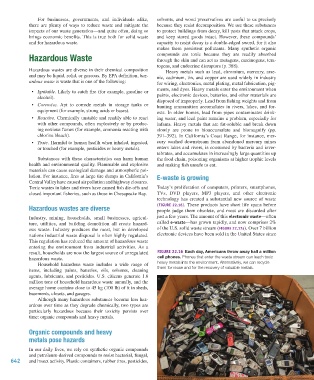Page 643 - Environment: The Science Behind the Stories
P. 643
For businesses, governments, and individuals alike, solvents, and wood preservatives are useful to us precisely
there are plenty of ways to reduce waste and mitigate the because they resist decomposition. We use these substances
impacts of our waste generation—and quite often, doing so to protect buildings from decay, kill pests that attack crops,
brings economic benefits. This is true both for solid waste and keep stored goods intact. However, these compounds’
and for hazardous waste. capacity to resist decay is a double-edged sword, for it also
makes them persistent pollutants. Many synthetic organic
Hazardous Waste compounds are toxic because they are readily absorbed
through the skin and can act as mutagens, carcinogens, tera-
togens, and endocrine disruptors (p. 388).
Hazardous wastes are diverse in their chemical composition Heavy metals such as lead, chromium, mercury, arse-
and may be liquid, solid, or gaseous. By EPA definition, haz- nic, cadmium, tin, and copper are used widely in industry
ardous waste is waste that is one of the following: for wiring, electronics, metal plating, metal fabrication, pig-
ments, and dyes. Heavy metals enter the environment when
• Ignitable. Likely to catch fire (for example, gasoline or
alcohol). paints, electronic devices, batteries, and other materials are
disposed of improperly. Lead from fishing weights and from
• Corrosive. Apt to corrode metals in storage tanks or hunting ammunition accumulates in rivers, lakes, and for-
equipment (for example, strong acids or bases). ests. In older homes, lead from pipes contaminates drink-
• Reactive. Chemically unstable and readily able to react ing water, and lead paint remains a problem, especially for
with other compounds, often explosively or by produc- infants. Heavy metals that are fat-soluble and break down
ing noxious fumes (for example, ammonia reacting with slowly are prone to bioaccumulate and biomagnify (pp.
chlorine bleach). 391–392). In California’s Coast Range, for instance, mer-
• Toxic. Harmful to human health when inhaled, ingested, cury washed downstream from abandoned mercury mines
or touched (for example, pesticides or heavy metals). enters lakes and rivers, is consumed by bacteria and inver-
tebrates, and accumulates in increasingly large quantities up
Substances with these characteristics can harm human the food chain, poisoning organisms at higher trophic levels
health and environmental quality. Flammable and explosive and making fish unsafe to eat.
materials can cause ecological damage and atmospheric pol-
lution. For instance, fires at large tire dumps in California’s E-waste is growing
Central Valley have caused air pollution and highway closures.
Toxic wastes in lakes and rivers have caused fish die-offs and Today’s proliferation of computers, printers, smartphones,
closed important fisheries, such as those in Chesapeake Bay. TVs, DVD players, MP3 players, and other electronic
technology has created a substantial new source of waste
Hazardous wastes are diverse (FIGURE 22.16). These products have short life spans before
people judge them obsolete, and most are discarded after
Industry, mining, households, small businesses, agricul- just a few years. The amount of this electronic waste—often
ture, utilities, and building demolition all create hazard- called e-waste—has grown rapidly, and now comprises 2%
ous waste. Industry produces the most, but in developed of the U.S. solid waste stream (FIGURE 22.17a). Over 7 billion
nations industrial waste disposal is often highly regulated. electronic devices have been sold in the United States since
This regulation has reduced the amount of hazardous waste
entering the environment from industrial activities. As a
result, households are now the largest source of unregulated FIGURE 22.16 Each day, Americans throw away half a million
hazardous waste. cell phones. Phones that enter the waste stream can leach toxic
Household hazardous waste includes a wide range of heavy metals into the environment. Alternatively, we can recycle
items, including paints, batteries, oils, solvents, cleaning them for reuse and for the recovery of valuable metals.
agents, lubricants, and pesticides. U.S. citizens generate 1.6
million tons of household hazardous waste annually, and the
average home contains close to 45 kg (100 lb) of it in sheds,
basements, closets, and garages.
Although many hazardous substances become less haz-
ardous over time as they degrade chemically, two types are
particularly hazardous because their toxicity persists over
time: organic compounds and heavy metals.
Organic compounds and heavy
metals pose hazards
In our daily lives, we rely on synthetic organic compounds
and petroleum-derived compounds to resist bacterial, fungal,
642 and insect activity. Plastic containers, rubber tires, pesticides,
M22_WITH7428_05_SE_C22.indd 642 13/12/14 2:25 PM

